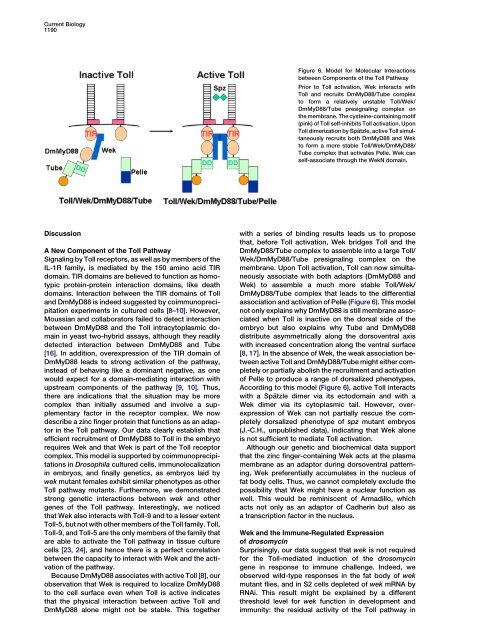Article Weckle Is a Zinc Finger Adaptor of the Toll Pathway in ...
Article Weckle Is a Zinc Finger Adaptor of the Toll Pathway in ...
Article Weckle Is a Zinc Finger Adaptor of the Toll Pathway in ...
You also want an ePaper? Increase the reach of your titles
YUMPU automatically turns print PDFs into web optimized ePapers that Google loves.
Current Biology<br />
1190<br />
Figure 6. Model for Molecular Interactions<br />
between Components <strong>of</strong> <strong>the</strong> <strong>Toll</strong> <strong>Pathway</strong><br />
Prior to <strong>Toll</strong> activation, Wek <strong>in</strong>teracts with<br />
<strong>Toll</strong> and recruits DmMyD88/Tube complex<br />
to form a relatively unstable <strong>Toll</strong>/Wek/<br />
DmMyD88/Tube presignal<strong>in</strong>g complex on<br />
<strong>the</strong> membrane. The cyste<strong>in</strong>e-conta<strong>in</strong><strong>in</strong>g motif<br />
(p<strong>in</strong>k) <strong>of</strong> <strong>Toll</strong> self-<strong>in</strong>hibits <strong>Toll</strong> activation. Upon<br />
<strong>Toll</strong> dimerization by Spätzle, active <strong>Toll</strong> simultaneously<br />
recruits both DmMyD88 and Wek<br />
to form a more stable <strong>Toll</strong>/Wek/DmMyD88/<br />
Tube complex that activates Pelle. Wek can<br />
self-associate through <strong>the</strong> WekN doma<strong>in</strong>.<br />
Discussion<br />
A New Component <strong>of</strong> <strong>the</strong> <strong>Toll</strong> <strong>Pathway</strong><br />
Signal<strong>in</strong>g by <strong>Toll</strong> receptors, as well as by members <strong>of</strong> <strong>the</strong><br />
IL-1R family, is mediated by <strong>the</strong> 150 am<strong>in</strong>o acid TIR<br />
doma<strong>in</strong>. TIR doma<strong>in</strong>s are believed to function as homotypic<br />
prote<strong>in</strong>-prote<strong>in</strong> <strong>in</strong>teraction doma<strong>in</strong>s, like death<br />
doma<strong>in</strong>s. Interaction between <strong>the</strong> TIR doma<strong>in</strong>s <strong>of</strong> <strong>Toll</strong><br />
and DmMyD88 is <strong>in</strong>deed suggested by coimmunoprecipitation<br />
experiments <strong>in</strong> cultured cells [8–10]. However,<br />
Moussian and collaborators failed to detect <strong>in</strong>teraction<br />
between DmMyD88 and <strong>the</strong> <strong>Toll</strong> <strong>in</strong>tracytoplasmic doma<strong>in</strong><br />
<strong>in</strong> yeast two-hybrid assays, although <strong>the</strong>y readily<br />
detected <strong>in</strong>teraction between DmMyD88 and Tube<br />
[16]. In addition, overexpression <strong>of</strong> <strong>the</strong> TIR doma<strong>in</strong> <strong>of</strong><br />
DmMyD88 leads to strong activation <strong>of</strong> <strong>the</strong> pathway,<br />
<strong>in</strong>stead <strong>of</strong> behav<strong>in</strong>g like a dom<strong>in</strong>ant negative, as one<br />
would expect for a doma<strong>in</strong>-mediat<strong>in</strong>g <strong>in</strong>teraction with<br />
upstream components <strong>of</strong> <strong>the</strong> pathway [9, 10]. Thus,<br />
<strong>the</strong>re are <strong>in</strong>dications that <strong>the</strong> situation may be more<br />
complex than <strong>in</strong>itially assumed and <strong>in</strong>volve a supplementary<br />
factor <strong>in</strong> <strong>the</strong> receptor complex. We now<br />
describe a z<strong>in</strong>c f<strong>in</strong>ger prote<strong>in</strong> that functions as an adaptor<br />
<strong>in</strong> <strong>the</strong> <strong>Toll</strong> pathway. Our data clearly establish that<br />
efficient recruitment <strong>of</strong> DmMyD88 to <strong>Toll</strong> <strong>in</strong> <strong>the</strong> embryo<br />
requires Wek and that Wek is part <strong>of</strong> <strong>the</strong> <strong>Toll</strong> receptor<br />
complex. This model is supported by coimmunoprecipitations<br />
<strong>in</strong> Drosophila cultured cells, immunolocalization<br />
<strong>in</strong> embryos, and f<strong>in</strong>ally genetics, as embryos laid by<br />
wek mutant females exhibit similar phenotypes as o<strong>the</strong>r<br />
<strong>Toll</strong> pathway mutants. Fur<strong>the</strong>rmore, we demonstrated<br />
strong genetic <strong>in</strong>teractions between wek and o<strong>the</strong>r<br />
genes <strong>of</strong> <strong>the</strong> <strong>Toll</strong> pathway. Interest<strong>in</strong>gly, we noticed<br />
that Wek also <strong>in</strong>teracts with <strong>Toll</strong>-9 and to a lesser extent<br />
<strong>Toll</strong>-5, but not with o<strong>the</strong>r members <strong>of</strong> <strong>the</strong> <strong>Toll</strong> family. <strong>Toll</strong>,<br />
<strong>Toll</strong>-9, and <strong>Toll</strong>-5 are <strong>the</strong> only members <strong>of</strong> <strong>the</strong> family that<br />
are able to activate <strong>the</strong> <strong>Toll</strong> pathway <strong>in</strong> tissue culture<br />
cells [23, 24], and hence <strong>the</strong>re is a perfect correlation<br />
between <strong>the</strong> capacity to <strong>in</strong>teract with Wek and <strong>the</strong> activation<br />
<strong>of</strong> <strong>the</strong> pathway.<br />
Because DmMyD88 associates with active <strong>Toll</strong> [8], our<br />
observation that Wek is required to localize DmMyD88<br />
to <strong>the</strong> cell surface even when <strong>Toll</strong> is active <strong>in</strong>dicates<br />
that <strong>the</strong> physical <strong>in</strong>teraction between active <strong>Toll</strong> and<br />
DmMyD88 alone might not be stable. This toge<strong>the</strong>r<br />
with a series <strong>of</strong> b<strong>in</strong>d<strong>in</strong>g results leads us to propose<br />
that, before <strong>Toll</strong> activation, Wek bridges <strong>Toll</strong> and <strong>the</strong><br />
DmMyD88/Tube complex to assemble <strong>in</strong>to a large <strong>Toll</strong>/<br />
Wek/DmMyD88/Tube presignal<strong>in</strong>g complex on <strong>the</strong><br />
membrane. Upon <strong>Toll</strong> activation, <strong>Toll</strong> can now simultaneously<br />
associate with both adaptors (DmMyD88 and<br />
Wek) to assemble a much more stable <strong>Toll</strong>/Wek/<br />
DmMyD88/Tube complex that leads to <strong>the</strong> differential<br />
association and activation <strong>of</strong> Pelle (Figure 6). This model<br />
not only expla<strong>in</strong>s why DmMyD88 is still membrane associated<br />
when <strong>Toll</strong> is <strong>in</strong>active on <strong>the</strong> dorsal side <strong>of</strong> <strong>the</strong><br />
embryo but also expla<strong>in</strong>s why Tube and DmMyD88<br />
distribute asymmetrically along <strong>the</strong> dorsoventral axis<br />
with <strong>in</strong>creased concentration along <strong>the</strong> ventral surface<br />
[8, 17]. In <strong>the</strong> absence <strong>of</strong> Wek, <strong>the</strong> weak association between<br />
active <strong>Toll</strong> and DmMyD88/Tube might ei<strong>the</strong>r completely<br />
or partially abolish <strong>the</strong> recruitment and activation<br />
<strong>of</strong> Pelle to produce a range <strong>of</strong> dorsalized phenotypes.<br />
Accord<strong>in</strong>g to this model (Figure 6), active <strong>Toll</strong> <strong>in</strong>teracts<br />
with a Spätzle dimer via its ectodoma<strong>in</strong> and with a<br />
Wek dimer via its cytoplasmic tail. However, overexpression<br />
<strong>of</strong> Wek can not partially rescue <strong>the</strong> completely<br />
dorsalized phenotype <strong>of</strong> spz mutant embryos<br />
(J.-C.H., unpublished data), <strong>in</strong>dicat<strong>in</strong>g that Wek alone<br />
is not sufficient to mediate <strong>Toll</strong> activation.<br />
Although our genetic and biochemical data support<br />
that <strong>the</strong> z<strong>in</strong>c f<strong>in</strong>ger-conta<strong>in</strong><strong>in</strong>g Wek acts at <strong>the</strong> plasma<br />
membrane as an adaptor dur<strong>in</strong>g dorsoventral pattern<strong>in</strong>g,<br />
Wek preferentially accumulates <strong>in</strong> <strong>the</strong> nucleus <strong>of</strong><br />
fat body cells. Thus, we cannot completely exclude <strong>the</strong><br />
possibility that Wek might have a nuclear function as<br />
well. This would be rem<strong>in</strong>iscent <strong>of</strong> Armadillo, which<br />
acts not only as an adaptor <strong>of</strong> Cadher<strong>in</strong> but also as<br />
a transcription factor <strong>in</strong> <strong>the</strong> nucleus.<br />
Wek and <strong>the</strong> Immune-Regulated Expression<br />
<strong>of</strong> drosomyc<strong>in</strong><br />
Surpris<strong>in</strong>gly, our data suggest that wek is not required<br />
for <strong>the</strong> <strong>Toll</strong>-mediated <strong>in</strong>duction <strong>of</strong> <strong>the</strong> drosomyc<strong>in</strong><br />
gene <strong>in</strong> response to immune challenge. Indeed, we<br />
observed wild-type responses <strong>in</strong> <strong>the</strong> fat body <strong>of</strong> wek<br />
mutant flies, and <strong>in</strong> S2 cells depleted <strong>of</strong> wek mRNA by<br />
RNAi. This result might be expla<strong>in</strong>ed by a different<br />
threshold level for wek function <strong>in</strong> development and<br />
immunity: <strong>the</strong> residual activity <strong>of</strong> <strong>the</strong> <strong>Toll</strong> pathway <strong>in</strong>



